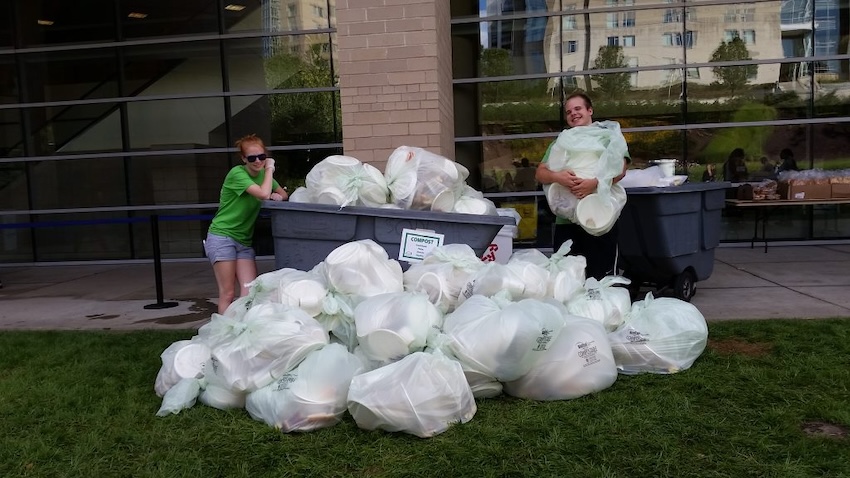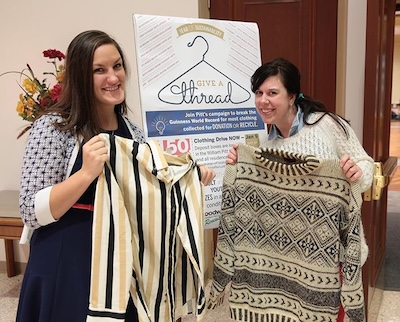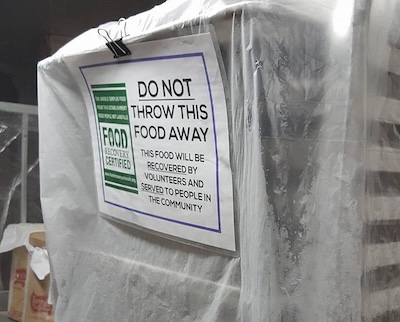Thriftsburgh, the Student Office of Sustainability, and Food Recovery Heroes began in classrooms and clubs 10 years ago. Today, they are foundational Pitt sustainability initiatives.

Nearly 11 years ago, the Office of the Provost announced its first Year of … at Pitt — the 2014-15 academic year would be the the Year of Sustainability.
Over the next year, Pitt established several lasting green initiatives, including the University-wide expansion of the Mascaro Center for Sustainable Innovation’s academic and research programs, the creation of a Faculty Sustainability Task Force and the launch of the first Pitt Sustainability Awards. Growing enthusiasm and increased funding also accelerated momentum for student-led environmental projects.
Keep reading to see how they’ve grown over the past decade.
From T-shirts to Thriftsburgh
Paul Heffernan (A&S ’15) still remembers the moment the idea for The University of Thriftsburgh clicked.
“We got fed up with every event having a free T-shirt and seeing tons of clothing waste all over campus,” he said. “We were broke college students without money for clothes, and we saw this obvious connection — affordable clothing demand meeting the constant supply of gently used clothes generated on campus.”

The concept was born in Instructor Ward Allebach’s sustainability course, where students addressed environmental issues they saw firsthand. Heffernan’s group launched a massive donation drive that collected more than 110,000 pieces of clothing — just shy of a world record — and helped stock a new on-campus thrift store.
When Thriftsburgh finally opened in Spring 2015, Heffernan was about to graduate. “Seeing it become popular during my senior year was pretty exciting stuff.”
Since then, Thriftsburgh has become a staple on campus. The shop now processes over a ton of clothing donations per year and sells more than 10,000 items annually. It also helps organize the Clutter for a Cause zero-waste move-out event each spring and the Reuse Rummage Sale every fall.
Students feeding students
While Thriftsburgh tackled textile waste, another group of students focused on finding a solution to food waste and food insecurity on campus. They soon launched Food Recovery Heroes as part of the national Food Recovery Network, which mobilizes students across the U.S. to reduce food waste and hunger by redirecting surplus meals to local nonprofits.

Jessica Simon (A&S, SOC WK ’17) was one of the first volunteers to join. “I signed up outside the student union one day and was hooked,” she said. “I started helping with logistics and coordinating donations, and pretty soon, it was a major part of my college life.”
Transportation was the group’s biggest headache. “A lot of students didn’t have cars, but we needed to move food fast,” Simon said. The group partnered with Zipcar and even used a bike trailer to bridge the gap, sometimes hauling trays of uneaten meals by bicycle through the streets of Pittsburgh’s Oakland neighborhood.
Since 2014, the group has worked with Pitt Dining Services to recover nearly 250,000 pounds of surplus food from dining halls and other campus locations, redistributing it to the Pitt Pantry and local hunger relief organizations, including Jubilee Soup Kitchen, Wilkinsburg Community Ministry and Street Medicine at Pitt.
A hub for student sustainability
As Thriftsburgh and Food Recovery Heroes addressed specific needs, the Student Office of Sustainability (SOOS) was evolving from a loose collective into a structured University initiative, thanks in part to Chelsea Huddleston’s (A&S ’18) leadership.
As the inaugural SOOS director, Huddleston helped create a collaborative hub in William Pitt Union for roughly 20 sustainability-related student groups. SOOS organized events to connect students across initiatives, assisted with dining hall waste audits and helped advance collection of compostable materials on campus.
“There were a bunch of amazing student groups working in isolation,” Huddleston said. “Our goal was to bring them together and make sustainability feel cohesive.”
A big milestone for the group came during the 2016-17 academic year, when student representatives helped develop the first Pitt Sustainability Plan, ensuring student priorities shaped University strategy.
“It felt really exciting to feel like other people were excited about the same things,” Huddleston said about the planning process. “Even though we were cobbling together things from different departments, a lot of people at Pitt were excited about moving in the same direction that we were.”
